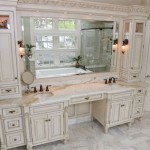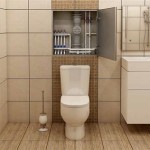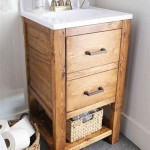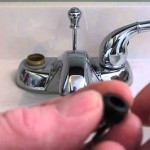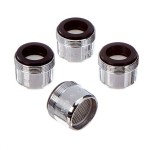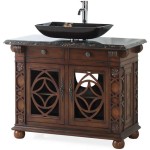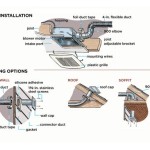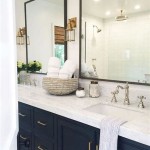How to Cover Pipes Under Bathroom Sink
The space beneath a bathroom sink can quickly become an eyesore, with exposed pipes and plumbing fixtures cluttering the area. Covering the pipes not only enhances the aesthetics of your bathroom but also provides a cleaner and more organized space. This article outlines the steps and considerations for effectively covering pipes under a bathroom sink, offering various approaches to suit different needs and preferences.
1. Assess the Space and Pipes
Before embarking on any covering project, it's crucial to thoroughly assess the space under the sink and the pipes themselves. This initial step will inform the choice of covering method and the materials required.
Begin by measuring the width and depth of the space available for covering. Note the location and configuration of the pipes, including their size and type. Consider any existing fixtures, like valves or drain traps, that would need to be accommodated. Identify any obstacles, such as electrical wiring or vent pipes, that might restrict the covering options.
Take note of the condition of the pipes. If they are corroded or leaking, it's advisable to address these issues before covering them. Replacing or repairing pipes in advance will ensure a clean and reliable foundation for the covering project.
2. Choose a Covering Method
Once the space and pipes have been thoroughly assessed, you can select the most appropriate covering method. Several options exist, each offering distinct advantages and disadvantages.
2.1 Cabinets and Drawers
Cabinets and drawers represent a classic and functional way to cover pipes under bathroom sinks. They offer ample storage space for toiletries, cleaning supplies, and other bathroom essentials. Cabinets are available in various styles and sizes, allowing you to choose one that seamlessly integrates with your bathroom decor.
When selecting a cabinet, ensure it is adequately sized to accommodate the pipes without obstructing access to fixtures. Consider the weight capacity of the cabinet, especially if you plan to store heavy items. Also, ensure that the cabinet's material is resistant to moisture and humidity, typical conditions in bathrooms.
2.2 Shelves and Baskets
For a less intrusive approach, open shelves and baskets can effectively conceal pipes while providing additional storage space. These options are particularly suitable for smaller bathrooms with limited floor space. Shelves can be made of wood, metal, or plastic, offering various styles and finishes to complement your bathroom's design.
When choosing shelves, consider the weight they can handle and the ease of cleaning. Baskets, on the other hand, offer flexibility and breathability. Opt for baskets made of durable materials like wicker, metal, or plastic to withstand moisture and wear. Choose baskets with handles for easy access and movement.
2.3 Wall-Mounted Organizers
Wall-mounted organizers offer a space-saving solution for covering pipes and maximizing storage. These organizers utilize vertical space, minimizing floor clutter and creating a less cramped feel. They come in various configurations, including shelves, hooks, and baskets, allowing you to customize the storage capacity and organization.
When selecting wall-mounted organizers, ensure they are securely attached to the wall and have sufficient weight capacity. Consider the materials used and their resistance to moisture and humidity. Choose organizers that blend with your bathroom decor and complement the overall aesthetic.
2.4 Fabric Panels or Curtains
For a more decorative and visually appealing approach, fabric panels or curtains can effectively hide pipes. These options are particularly suitable for creating a softer and more inviting ambiance. Fabric panels can be easily customized with different colors, patterns, and textures to create a unique and personal look.
Ensure the chosen fabric is waterproof, easily washable, and resistant to mildew. Consider attaching the panels or curtains to a simple frame or rod, ensuring they move freely and do not impede access to the pipes. Fabric panels or curtains can offer a versatile and aesthetic solution for covering pipes under a bathroom sink.
3. Installation and Finishing Touches
Once you've chosen the covering method, the next step is installation. The specific installation process will vary depending on the chosen option.
For cabinets or shelves, you might need to assemble them according to the manufacturer's instructions. This often involves attaching them to the wall using screws or brackets. For wall-mounted organizers, installation usually involves drilling holes in the wall and securing the organizer with screws. Fabric panels or curtains require a simple hanging mechanism, such as a rod or frame, which can be easily installed above the pipes.
After installing the covering element, it's important to ensure it is securely mounted and properly aligned. Adjust the position and alignment as needed to ensure the pipes are fully concealed and the covering element integrates seamlessly with the bathroom decor.
Consider adding finishing touches to enhance the overall look and feel of the covered space. This might involve decorating shelves with decorative items, placing plants or flowers, or simply arranging toiletries in a visually pleasing manner. The goal is to create a cohesive and aesthetically pleasing environment that enhances the bathroom's overall design.

Pin On Layouts

How To Hide Plumbing In Your Bathroom Victoriaplum Com

Pin On Bathroom

Creative Ways To Utilise The Under Sink Areas In Your Bathroom And Kitchen Hipcouch Complete Interiors Furniture

Whats Some Ways To Cover Up My Sink Pipes Hometalk

How To Hide Pipes On A Small Floating Si Bunnings Work Community

Pin By Wendy Van Alstyne On My Crafts Under Bathroom Sink Diy Vanity Sinks

Boxing In Bathroom Pipework Guru

Ask A Builder Hiding Pipes

Hiding Plumbing On Floating Vanity Hometalk
Related Posts
